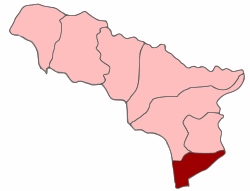Gali District, Abkhazia
|
Gali District გალის რაიონი Гал араион Гальский район |
|
|---|---|
| District | |
 Location of Gali district in Abkhazia |
|
| Country | Georgia |
| De Facto state | Abkhazia |
| Capital | Gali |
| Government | |
| • Governor | Temur Nadaraia Acting |
| Population (2003) | |
| • Total | 29,287 |
| Time zone | MSK (UTC+3) |
| Area differs from the administrative division of Georgia | |
|
|
|
|
|
Gali District is a district of Abkhazia. Its capital is Gali, the town by the same name. The district is smaller than the eponymous one in the de jure subdivision of Georgia, as some of its former territory is now part of Tkvarcheli District, formed by de facto Abkhaz authorities in 1995.
Gali District was populated almost entirely by Mingrelians, a Georgian regional subdivision, in the pre-war Abkhazia. The majority of Georgians fled the district following the inter-ethnic clashes in 1993–1994 and again in 1998. From 40,000 to 60,000 refugees have returned to Gali District since 1998, including persons commuting daily across the ceasefire line and those migrating seasonally in accordance with agricultural cycles. Gali District is now the only district of Abkhazia with ethnic Georgians constituting clear majority.
The population of the district was 29,287 according to the 2003 census conducted in Abkhazia but that figure is questioned by many international observers; it was estimated at 45 thousand in 2006 although Abkhazian authorities contested this number claiming that at least 65,000 refugees had returned.
Together with the Kodori Valley, Gali District is one of the two real troublespots while the situation is relatively peaceful in the rest of Abkhazia. It was a battlefield of the 1998 escalation of the Georgian-Abkhaz conflict.
Historically, the present-day Gali District constituted the borderland between the principalities of Abkhazia and Samegrelo, the two breakaway feudal domains of the Kingdom of Georgia, and frequently changed its masters as the borders of these princedoms fluctuated during the dynastic feuds between the Shervashidze and Dadiani clans. In the second half of the 17th century, the Shervashidze princes of Abkhazia succeeded in conquering the territories up the Inguri River including the Gali District. With the dissolution of the Principality of Abkhazia c. 1700, the district between the Galidzga to the Inguri came to be ruled by a branch of the Shervashidze family whose one member, Murzakan, gave to his new fiefdom the name "Samurzakano" (i.e., "land of Murzakan"). The upper class of this new principality was composed chiefly of the Georgian-speaking Abkhaz nobility, whereas the peasants were of both Abkhaz and Georgian (Mingrelian) background. In contrast to the rest of Abkhazia largely Islamized under the Ottoman Empire, Samurzakano remained adherent to the Georgian Orthodox Christianity. Eventually the princedom came under the Mingrelian possession, but retained a degree of autonomy even after the expanding Imperial Russia established its protectorate over Mingrelia in 1804. In 1840, however, Russia outrightly annexed Samurzakano. In the 1860s–70s, the Abkhaz revolts and the systematic persecution of Muslim population at the hands of Russian authorities forced many Abkhaz to become Muhajirs to the Ottoman possessions. The Orthodox Christian population of Samurzakano remained relatively unaffected though. The decline in Abkhaz population left Mingrelian a dominant culture in the area. Furthermore, some Georgian peasants from the left bank of the Inguri River also emigrated to the right bank into Abkhazia where weaker practices of serfdom prevailed.
...
Wikipedia
